
Outdoor plants that also thrive indoors
to enhance the conservatory and the house
Contents
Some outdoor plants are not solely intended to beautify our gardens and can wonderfully decorate our interiors. These are generally bushes with evergreen foliage or perennials that thrive in the warmth of a living room, the humidity of a bathroom, or the brightness of a conservatory. Outdoor varieties will add a touch of originality and exoticism if you take care to meet their needs.
Discover with us some outdoor plants that also grow indoors, to enhance the conservatory and the home!
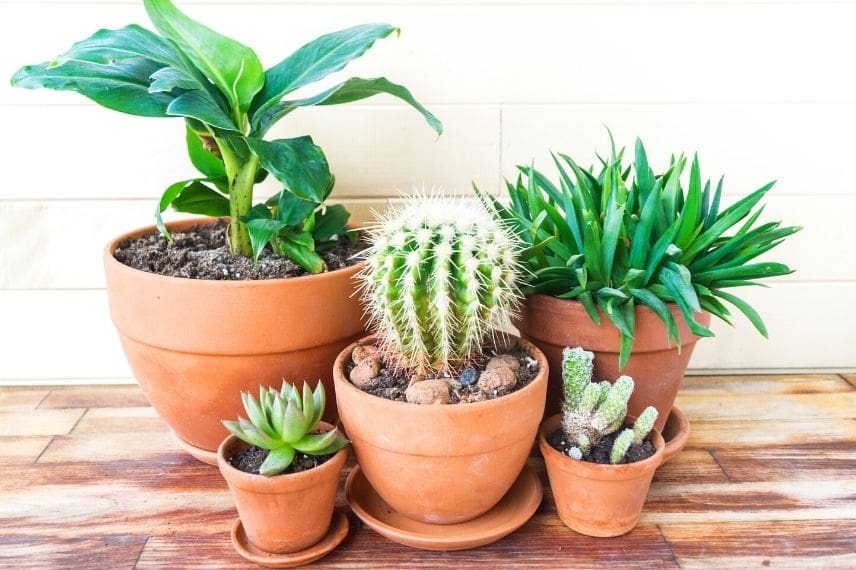
Banana plants, cacti, and succulents are suitable for both outdoor and indoor settings
Outdoor plants for a conservatory
Banana Plants
The banana plant is a stunning tropical plant, perfectly suited to the heat and humidity of a conservatory. Contrary to popular belief, it is an easy bush to grow if the right growing conditions are met. It enjoys a bright, sunny exposure or bright light. In the shade, it tends to become leggy in search of light. Its substrate should always be kept slightly moist, without excess, and never allowed to dry out. Greedy, the potted banana plant needs rich potting soil, as well as weekly fertilisation from April to September, and then once a month during the winter phase. Beautiful but bulky, choose smaller varieties, such as Musa acuminata ‘Dwarf Cavendish’ or Musa velutina. Feel free to take your banana plant outside to the terrace or garden during the warm season; your plant will thrive.

Dwarf Bamboos
With their small sizes and elegant culms, dwarf bamboos will bring a lovely exotic touch from Asia to your conservatory. Rather demanding and a bit tricky to grow, bamboo will need a bright conservatory but cannot tolerate direct sunlight during the summer. If your conservatory faces south, it will need to be moved to partial shade during the warm season, either in the garden or on the terrace. Its substrate should be watered regularly to keep it fresh at all times, but without excess to prevent root rot. This vigorous plant will need to be repotted every year at the end of winter. To avoid being overwhelmed, unless you wish to live in a lush jungle, opt for smaller varieties, such as Sasa tessellata, Sasa tsuboiana, or Shibataea kumasaca. The Fargesia murielae ‘Bimbo’ will also be interesting for its spreading silhouette, giving it a wild appearance. As it enjoys humidity, bamboo is difficult to grow indoors. Only the tiny Pogonatherum paniceum will adapt well in a bright bathroom or any other room with regularly misted foliage.
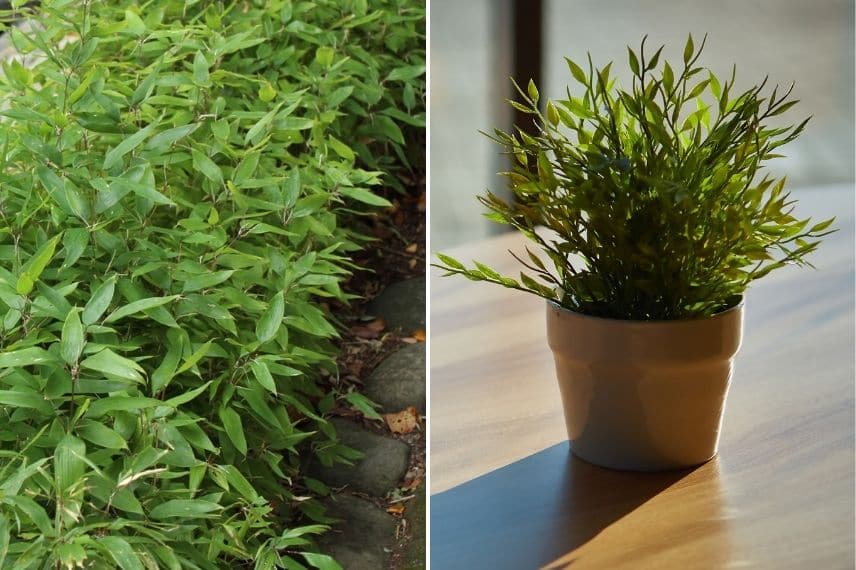
On the left: Shibataea kumasaca; on the right: Pogonatherum paniceum
Palms for the Conservatory and Home
Palms are magnificent tropical plants, adding a touch of exoticism to our interiors. To thrive, they require full sun, except during the hottest hours of the day in summer. Not demanding, the palm can spend the winter in a cool conservatory or indoors behind a large bay window. Accustomed to subtropical areas, it needs a humid atmosphere found in our unheated conservatories. Indoors, its foliage should be misted regularly to prevent it from drying out. Choose a small variety, such as Phoenix roebelinii, which is a dwarf version of the date palm, or Rhapis excelsa for its beautiful bamboo palm silhouette.
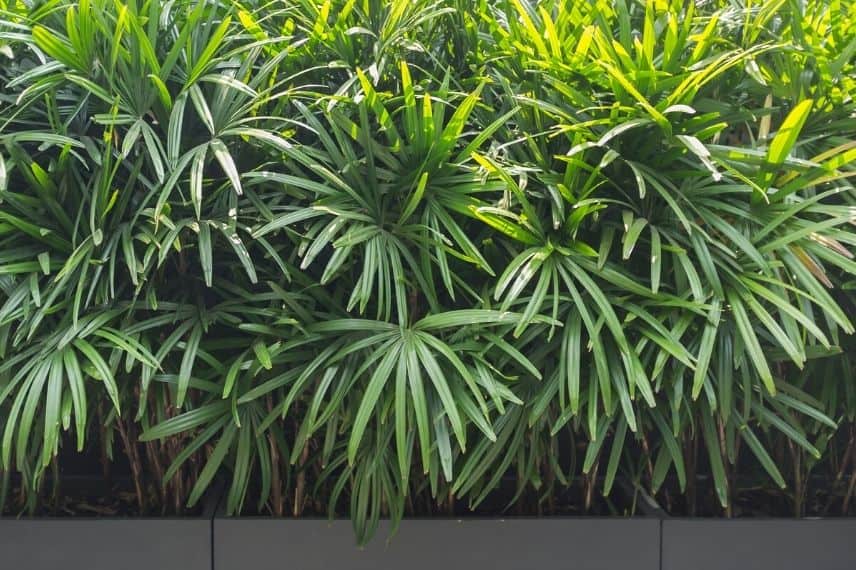
Rhapis excelsa (Bamboo Palm)
Citrus Trees
Originating from Asia, lemon trees, kumquats, and other citrus trees are highly valued for their delicious, fragrant, and colourful fruits. Quite demanding, citrus trees fear the cold but thrive in pots, sheltered in a conservatory during winter. If a conservatory is not available, they will adapt to a very bright room, in front of a south-facing window, but not too warm (up to 17-18°C maximum). Indoors, their foliage should be misted every 2 to 3 days. To keep a citrus tree in top condition and encourage pollination, it should be taken out onto the terrace or balcony in spring and summer. Preferably choose small varieties with moderate growth, such as Calamondin (apartment orange tree), Citron, Meyer Lemon, and Kumquats.
Note: some indoor plants presented in the next chapter are very accommodating and will generally thrive well in a conservatory.
Outdoor plants for the home
Ferns for a Bathroom or Conservatory
Ferns ferns are beautiful green plants that thrive indoors if their humidity needs are met. They will be perfectly happy in a bathroom, a cool room, or a conservatory. In other rooms of the house, mist the foliage daily or place them among other plants to increase the ambient humidity. Their potting mix should always be moist but not soggy, which will require diligence and care. This understorey plant will enjoy being placed near a source of filtered light, for example, 1 to 2 m from a window. However, do not place it in a dark corner of the house or in direct sunlight, where it will quickly deteriorate. Among the prettiest varieties, one can highlight the graceful Elegant Maidenhair, the Boston Fern for its lush appearance, and the Pteris umbrosa with its exotic leaves.

Boston Fern (Nephrolepis cordifolia Arctic Jungle), Elegant Maidenhair (Adiantum venustum) and Pteris umbrosa
Colocasias for a Bright Room, Bathroom, or Conservatory
Colocasias, cousins of our indoor Alocasias, can also be grown in a bright room of the house or in a conservatory. This plant is highly valued for its large, colourful foliage, ranging from a lovely light green like that of Colocasia esculenta, to black in the variety ‘Black Magic’ or with pink petioles in Colocasia ‘Pink China’. It will appreciate light without direct sunlight, behind a sheer curtain or in front of a west-facing window. It also enjoys the ambient humidity of a bathroom or conservatory. In other rooms of the house, regularly mist its foliage with water. Its substrate should remain moist but not soggy.
The Aspidistra for a Dark Room
The Aspidistra elatior, known as “cast iron plant”, is the perfect example of a plant that thrives both indoors and outdoors. It was primarily cultivated indoors over half a century ago before making its way into our gardens. It forms a dense bouquet of large, dark green leaves, glossy and measuring 30 to 50 cm in height. In the variety ‘Milky Way’, the fine foliage is speckled with small white spots, while it is striped with cream white in Aspidistra elatior ‘Zebra’. Easy to grow and nearly foolproof, this lovely plant enjoys regular watering but can tolerate occasional neglect without fuss.The aspidistra will thrive away from light, without direct sunlight that could scorch its beautiful foliage. A dimly lit room, cool (up to 18°C in winter) or a north-facing window suits it perfectly.
Succulents and Cacti for a South-Facing Window
If you are looking for a plant suitable for a well-heated room in winter, but also near a sunny window, succulents and cacti are perfect for you! And if you are prone to forgetting to water, look no further; they will survive you. Indeed, they are easy to succeed with, even for a beginner or if you have little time to devote to them.
The Opuntia includes many varieties of prickly pear cacti, which are indeed spiny but beautifully decorative with their rounded pads. If you prefer ball cacti, the Echinopsis subdenudata will surprise you with its lovely urchin-like shape and its astonishingly fragrant bloom.
On the succulent side, you will be spoiled for choice between Agaves, Mangaves, Aloe, and Kalanchoe. Among the most beautiful, the Queen Victoria Agave stands out with its lovely dense rosette of light green leaves edged in white. Not to mention the Aloe vera, renowned for its beauty as well as its medicinal and cosmetic properties.
If the presence of thorns puts you off, consider non-spiny varieties, such as the tiny Anacampseros filamentosa with its green-grey foliage tinged with purple and the remarkable Crassula ‘Hobbit’ or ‘Minor’.
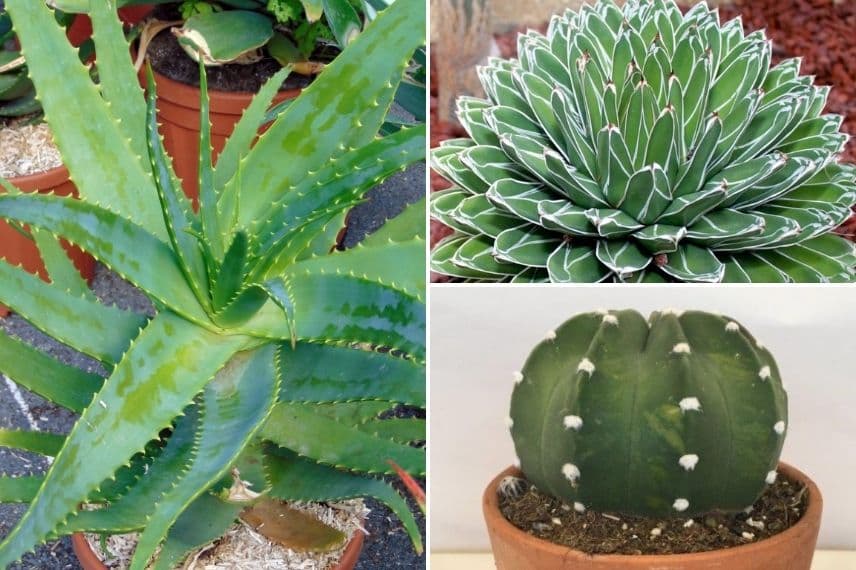
The Aloe vera, the Queen Victoria Agave, and the Echinopsis subdenudata
Fatsia and Fatshedera for a Low-Light Room
The Fatsia, also known as Aralia or Japanese Aralia, are among the plants that require little light. Easy to grow and not afraid of drafts, they can be placed in an entrance hall, next to a north-facing window, on a landing, or in a bright room but without direct sunlight. These bushes have a very exotic appearance with their large, palmate, glossy leaves. The foliage can be dark green like that of Fatsia japonica or beautifully variegated with cream white in Fatsia japonica ‘Spider’s Web’. Its cousin, Fatshedera, is a cross between ivy and aralia, earning it the nickname Aralia-ivy. One of the most beautiful varieties is undoubtedly the lovely Fatshedera lizei ‘Variegata’, with its large green ivy-like leaves variegated with white. Low-maintenance, it enjoys a fresh potting mix but tolerates occasional neglect.
- Subscribe!
- Contents

































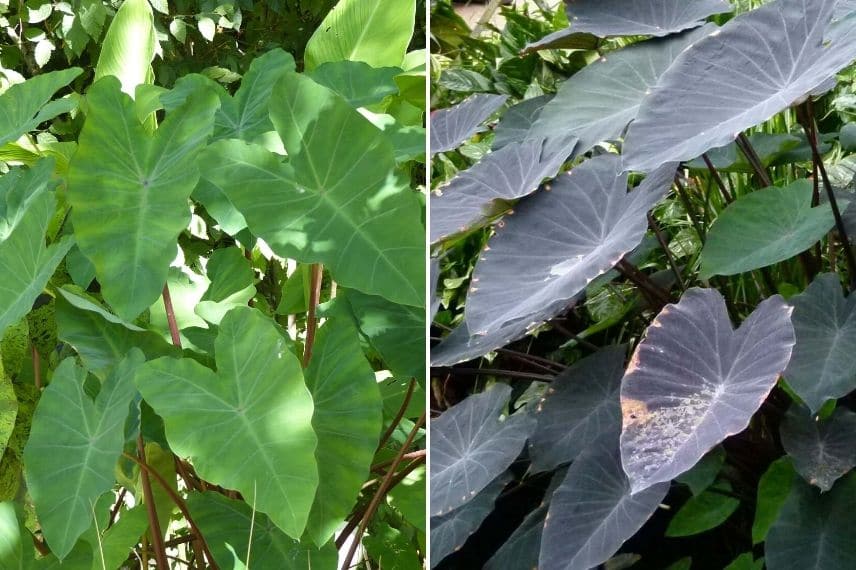


Comments